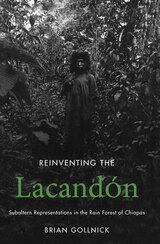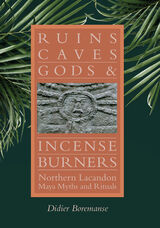2 books about Lacandon Indians

Reinventing the Lacandón
Subaltern Representations in the Rain Forest of Chiapas
Brian Gollnick
University of Arizona Press, 2008
Before massive deforestation began in the 1960s, the Lacandón jungle, which lies on the border of Mexico and Guatemala, was part of the largest tropical rain forest north of the Amazon. The destruction of the Lacandón occurred with little attention from the international press—until January 1, 1994, when a group of armed Maya rebels led by a charismatic spokesperson who called himself Subcomandante Marcos emerged from jungle communities and briefly occupied several towns in the Mexican state of Chiapas. These rebels, known as the Zapatista National Liberation Army, became front-page news around the globe, and they used their notoriety to issue rhetorically powerful communiqués that denounced political corruption, the Mexican government’s treatment of indigenous peoples, and the negative impact of globalization. As Brian Gollnick reveals, the Zapatista communiqués had deeper roots in the Mayan rain forest than Westerners realized—and he points out that the very idea of the jungle is also deeply rooted, though in different ways, in the Western imagination. Gollnick draws on theoretical innovations offered by subaltern studies to discover “oral traces” left by indigenous inhabitants in dominant cultural productions. He explores both how the jungle region and its inhabitants have been represented in literary writings from the time of the Spanish conquest to the present and how the indigenous people have represented themselves in such works, including post-colonial and anti-colonial narratives, poetry, video, and photography. His goal is to show how popular and elite cultures have interacted in creating depictions of life in the rain forest and to offer new critical vocabularies for analyzing forms of cross-cultural expression.
[more]

Ruins, Caves, Gods, and Incense Burners
Northern Lacandon Maya Myths and Rituals
Didier Boremanse
University of Utah Press, 2019
The Lacandon Maya are a small-scale forest society currently on the brink of extinction. Small groups of Northern Lacandon escaped evangelization by dispersing into the jungle, moving from the Guatemalan Petén to Chiapas in southern Mexico during the seventeenth, eighteenth, and nineteenth centuries. Several groups maintained their traditional religion until the late twentieth century.
Their cult of incense burners, based on the veneration of Maya ruins and funerary caves and the deities these effigy censers represented, remained free of any Christian influence. Some ceremonies were vestiges of more complex rituals believed to date back to pre-Columbian times. In this volume, Didier Boremanse explores Lacandon beliefs and traditions he observed during the many months of fieldwork he did, spanning four decades.
Throughout the book Boremanse makes Lacandon values and worldviews accessible to readers from western cultures. Rituals are described and explained with extracts of the celebrants’ prayers that were tape-recorded, transcribed, and translated. Other elements of religious oral tradition are included, including incantations, chants, and the myths and beliefs that sustain the rites. Boremanse also discusses how larger social change influences religious change, both through economic means and outside influences. Most of the myths retold in this book have never been published in English. Photographs show rites that are no longer performed and shrines that no longer exist.
Their cult of incense burners, based on the veneration of Maya ruins and funerary caves and the deities these effigy censers represented, remained free of any Christian influence. Some ceremonies were vestiges of more complex rituals believed to date back to pre-Columbian times. In this volume, Didier Boremanse explores Lacandon beliefs and traditions he observed during the many months of fieldwork he did, spanning four decades.
Throughout the book Boremanse makes Lacandon values and worldviews accessible to readers from western cultures. Rituals are described and explained with extracts of the celebrants’ prayers that were tape-recorded, transcribed, and translated. Other elements of religious oral tradition are included, including incantations, chants, and the myths and beliefs that sustain the rites. Boremanse also discusses how larger social change influences religious change, both through economic means and outside influences. Most of the myths retold in this book have never been published in English. Photographs show rites that are no longer performed and shrines that no longer exist.
[more]
READERS
Browse our collection.
PUBLISHERS
See BiblioVault's publisher services.
STUDENT SERVICES
Files for college accessibility offices.
UChicago Accessibility Resources
home | accessibility | search | about | contact us
BiblioVault ® 2001 - 2024
The University of Chicago Press









